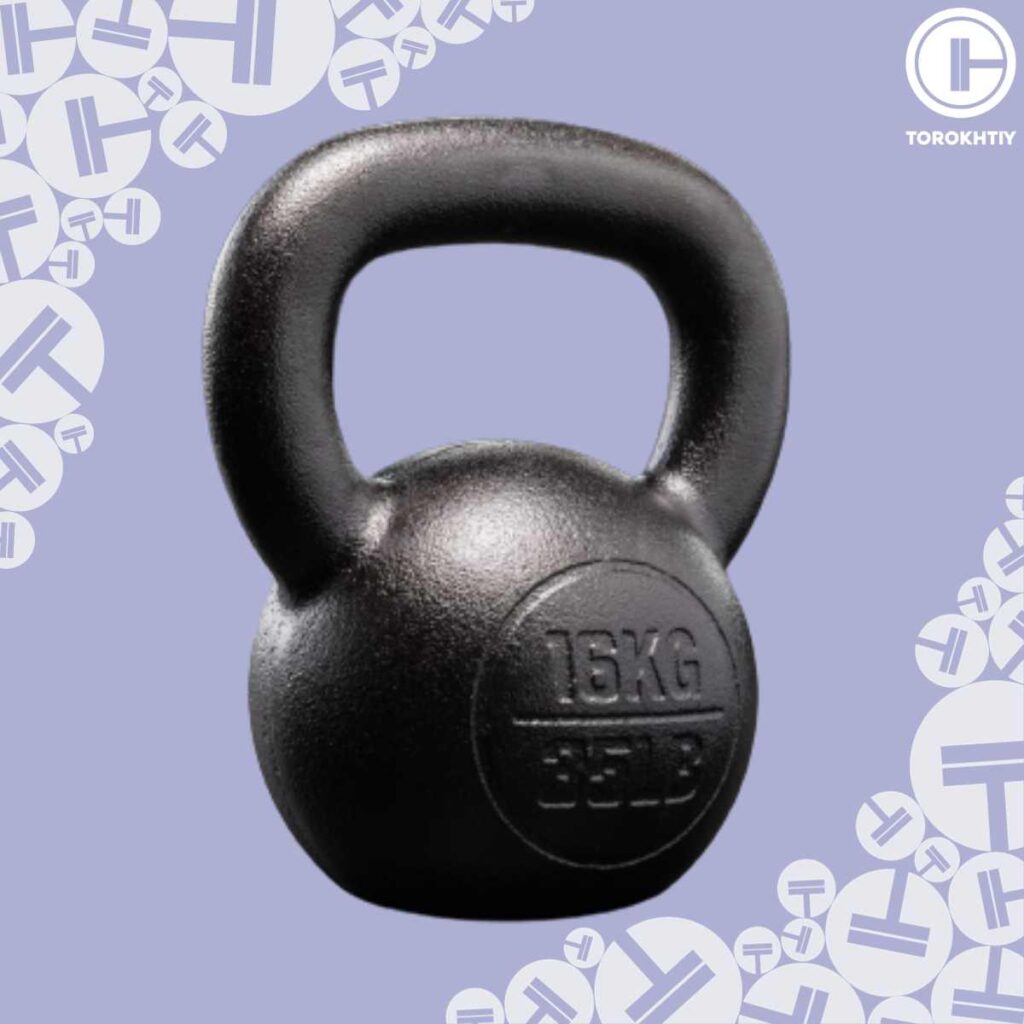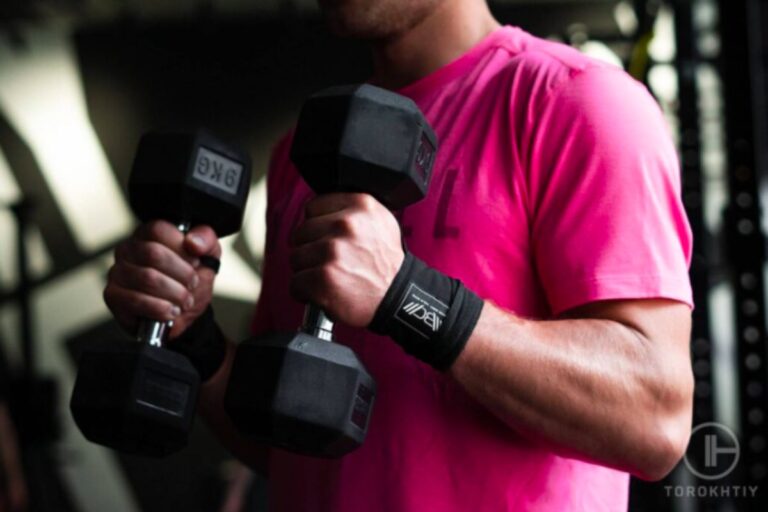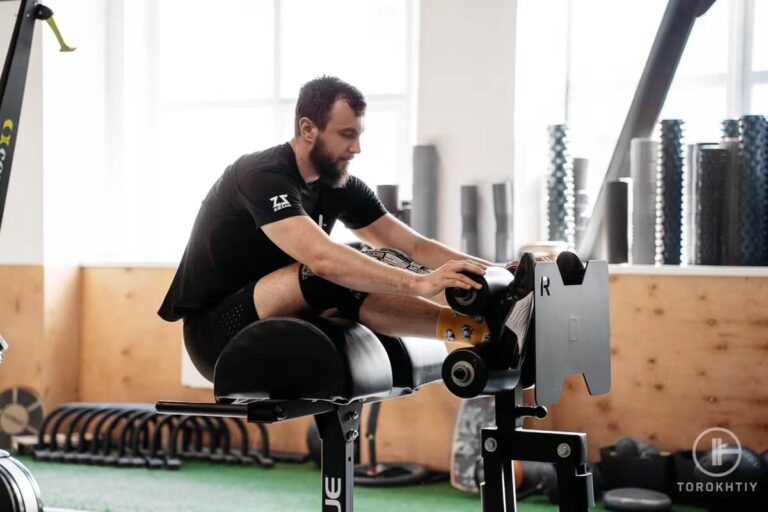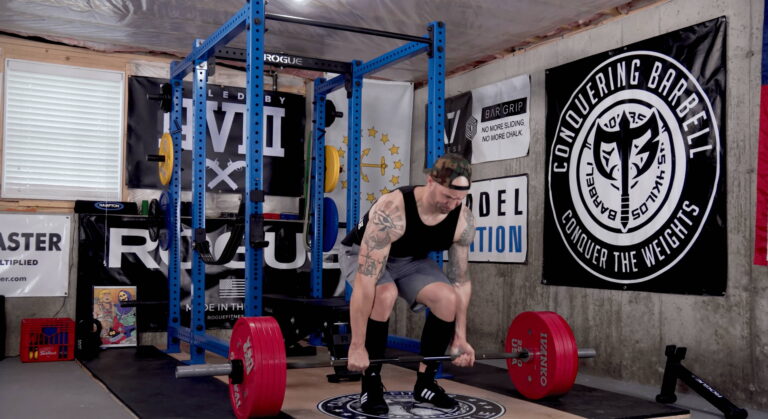What Muscles Do Kettlebell Swings Work?
Kettlebell swings show up in many workout routines including cross-training, functional fitness, physical therapy, and sports conditioning. Thanks to their near full-body nature, they can be incorporated into cardio exercise, functional fitness, and calorie shredding, among others. So, what muscles do kettlebell swings work, exactly?
The exercise is primarily used as a quick and effective way to train your posterior chain, but there are also other muscles used in kettlebell swings. Here’s a brief overview before we dive into the details:
What Muscles Do Kettlebell Swings Work? The muscles used in kettlebell swings primarily include the posterior chain, including the glutes, hamstrings, calves, traps, rhomboids, and erector spinae. They also activate the shoulders, abs, and forearms as a way to stabilize the movement.
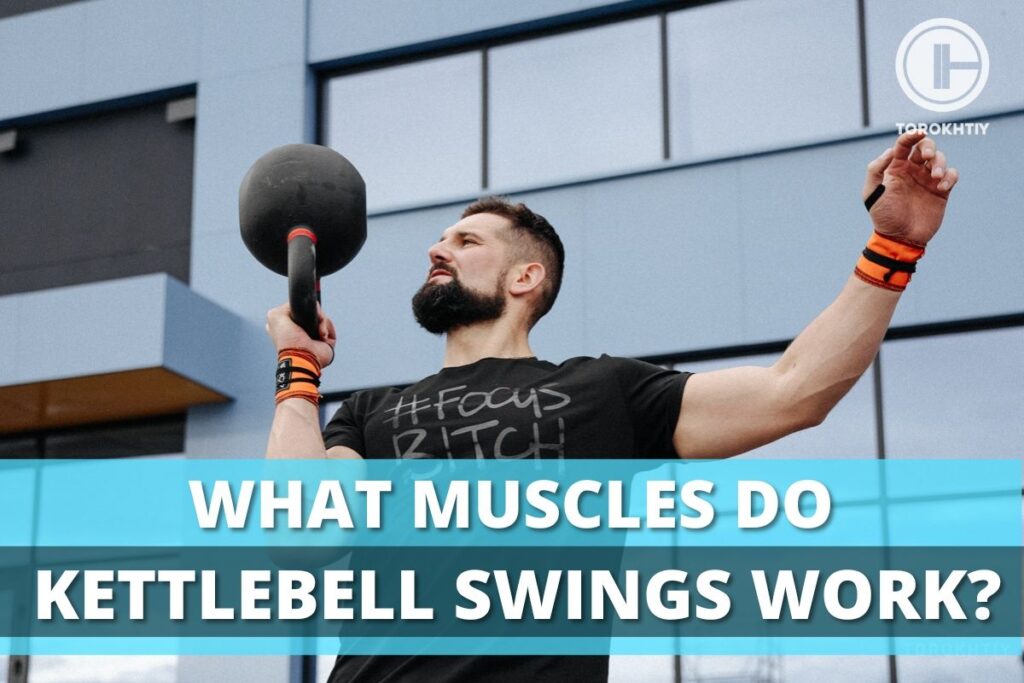
What Muscles Do Kettlebell Swings Work?
Kettlebell Swings are a well-rounded exercise that activates muscles necessary for daily life movement. So, what body parts do kettlebell swings work? Do kettlebell swings work glutes? What about the back? Here’s a quick overview, separated by primary and secondary muscle groups to make it easier to follow:
Primary Muscles
Primary muscles play an active role in our exercise. In other words, we make a conscious effort to activate them throughout the movement. The primary muscles worked by kettlebell swings include:
Glutes
A common question about the exercise is do kettlebell swings work glutes? Yes, Gluteal muscles (or buttocks) play a major role in hip control, particularly hip extensions. As such, they’re essential for generating power to perform the swing motion and contract the most when our body is straight and the kettlebell is at its peak.
Hamstrings
The Hamstrings are three muscles in the leg that cross 2 joints – the knee joint and the hip joint. Their main purpose in kettlebell swings is supporting and helping the glutes with hip extension – bringing your hips up/forward during the swing.
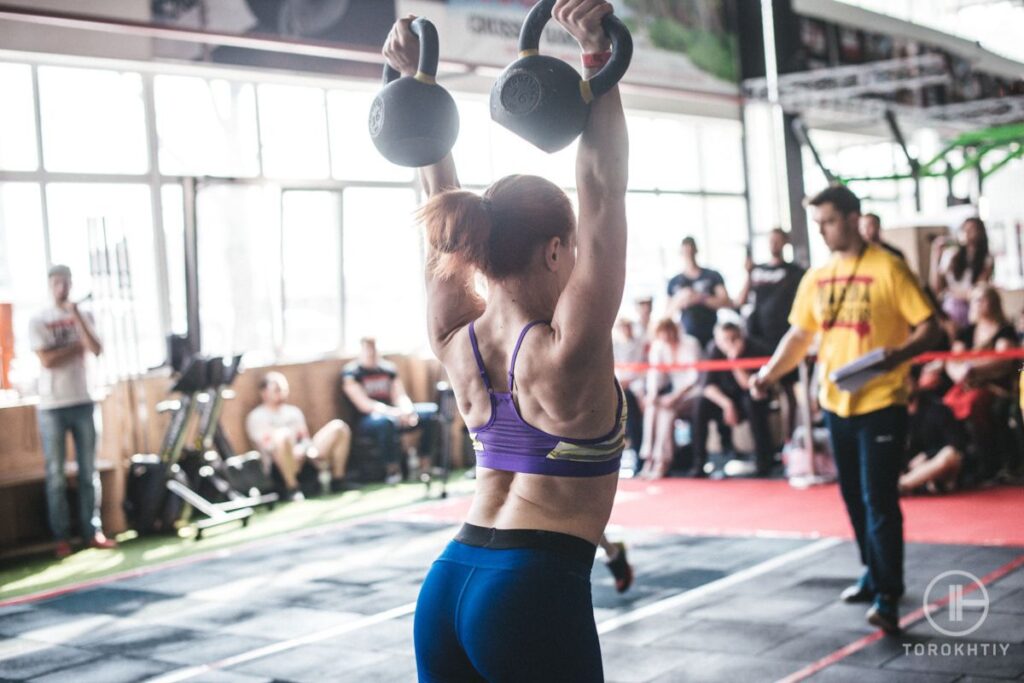
Calves
Calves are a group of lower leg muscles. During kettlebell swings, they stabilize and support our body by carrying the brunt of the weight, and are active throughout nearly the entire movement.
Trapezius
The Trapezius or simply traps is a large, triangular muscle located in the upper back and neck. It’s responsible for stabilizing the shoulders and upper back, especially ensuring the kettlebell doesn’t pull our upper body forward.
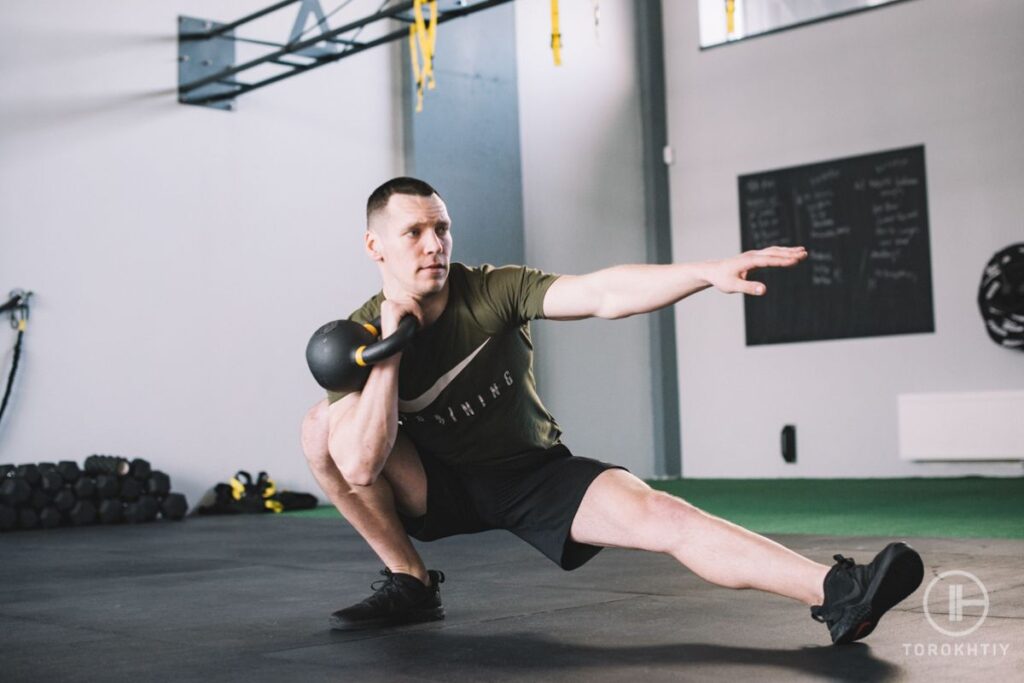
Rhomboids
The Rhomboids are a pair of muscles located underneath the Trapezius and between the shoulder blades. During kettlebell swings, they help us maintain posture in the upper back and keep the shoulders even.
Erector Spinae
The Erector Spinae are a major group of core muscles located on the back, that spring from the hips all the way up to our back neck. These muscles are essential for spinal health and maintaining a straight upper body during kettlebell swings.
Secondary muscles
Secondary muscles play a passive role throughout the exercise. They activate naturally to stabilize and support our body, as opposed to deliberate, conscious effort. Here are the secondary muscles worked in kettlebell swing exercises:
Abdominals
Abdominal muscles, or abs as they’re popularly called, are the frontal part of our core muscles. So, how does kettlebell swing work abs? During the exercise, abs work in tandem with other core muscles to stabilize our middle section and protect the lower back from unwanted movement.
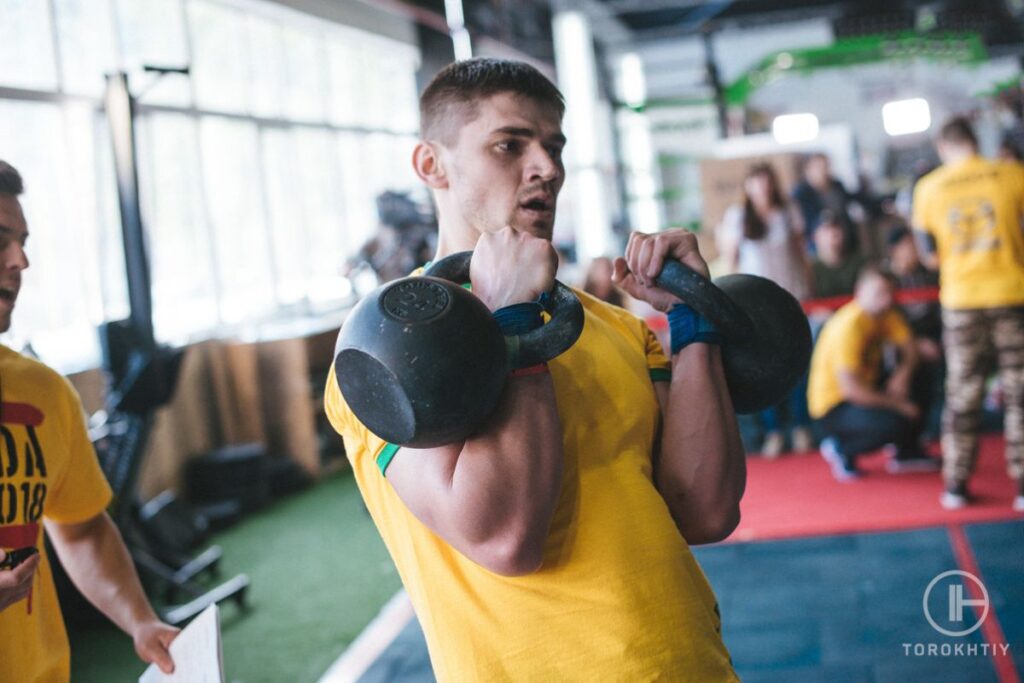
Rotator Cuff
The Rotator Cuff is a group of muscles and their tendons found in the shoulder. As you can guess from the name, they’re essential for shoulder rotation, which is a necessary motion to carry the kettlebell forward.
Forearms and Hands
Forearms and grip strength are essential for holding onto the kettlebell and activate especially on higher weight increments.
Mechanics of Kettlebell Swings
Kettlebell Swings are a fun and dynamic exercise with many uses. But what do kettlebell swings work on, exactly? Here’s what your body experiences during Kettlebell Swings:
Near Full-Body Workout
So, are kettlebell swings a full-body workout? In many ways, they are. They may not be as good at raw strength and muscle building as opposed to something like weightlifting, but they activate a large number of muscle groups at once.
Low-Impact Exercise
Despite utilizing weight for resistance, the kettlebell swing never directly presses your muscles and joints against the ground, instead relying on simple physics to stay suspended in the air. This makes the exercise inherently low-impact, safe, and easy on the body. Data also supports this. For instance, one study examining the effects of kettlebells on joints showed that athletes did not experience increased stress in the knee when using different weight increments.
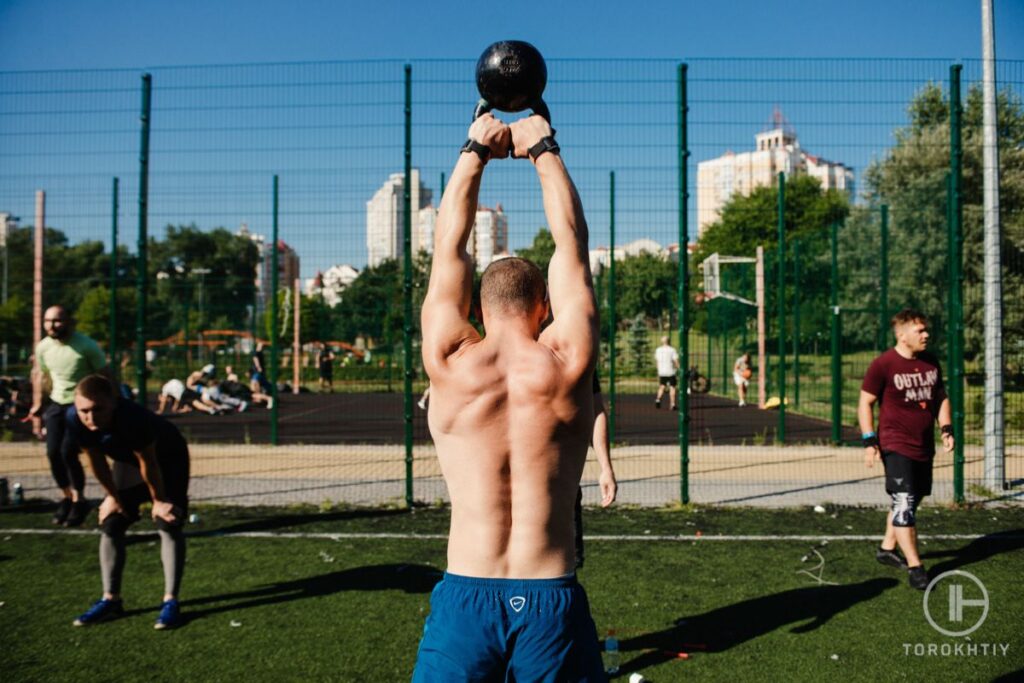
Cardiovascular Benefits
Kettlebell Swings are gaining popularity as an alternative to traditional cardiovascular exercises like walking and cycling. But just how good are they? One study comparing Kettlebell Swings to gradient treadmill walks found that metabolic responses (oxygen consumption, respiratory exchange ratio, calorie consumption, and blood pressure levels) were similar between the two exercises.
Another study comparing them to treadmill running found that, although running resulted in overall greater metabolic responses, Kettlebell Swings showed excellent results as well, confirming their usefulness as an alternative cardio exercise. Additional research into the exercise showed that regular Kettlebell Swings can increase aerobic capacity (stamina) regardless of weight increment or swing speed, confirming their usefulness at all fitness levels.
Functional Fitness
Another great thing about Kettlebell Swings is their ability to activate many biomechanical processes at the same time, making them highly beneficial in functional fitness. During kettlebell swings, our body works out explosive power, balance, stability, agility, hand-to-eye coordination, range of motion, grip strength, selective muscle activation, spatial awareness, and more.
These effects can be used in a variety of ways, including generally raising your fitness level, training for sports, improving your daily life, or physical therapy, to name a few.
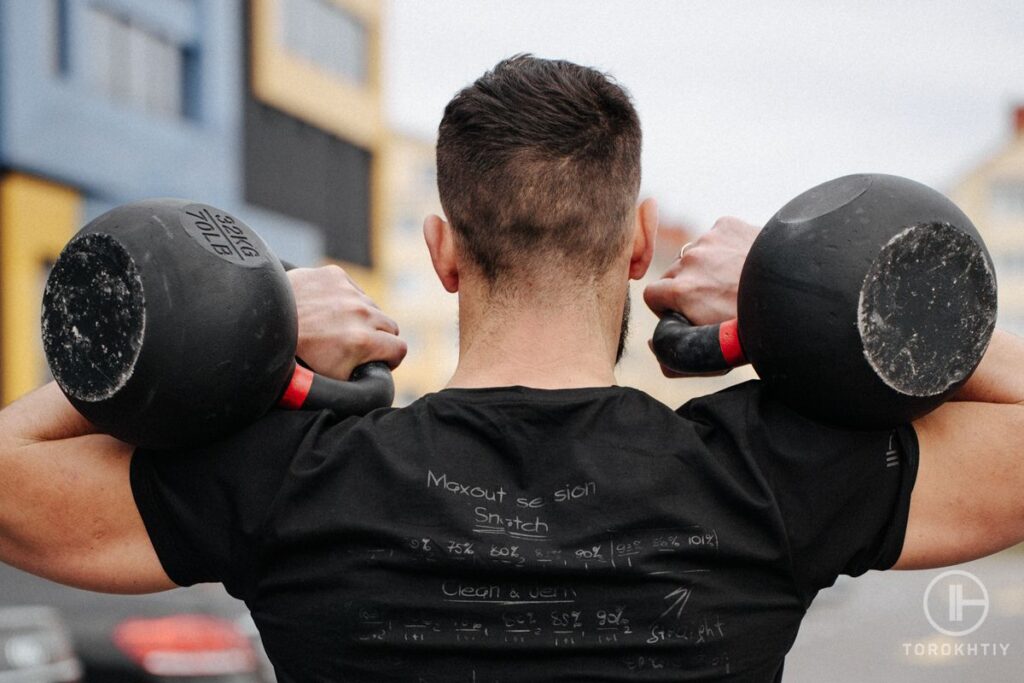
Posterior Chain Strength
The posterior chain muscle group plays a major role in daily life activities. We utilize the posterior chain every time we walk, run, lift objects, sit up and down, etc. Pretty much any movement that involves simultaneous use of the upper and lower body uses the posterior chain. In many ways, it can be said that it holds our body together.
Strengthening the posterior chain isn’t just about being fit, it is essential for back (spinal) health. Spinal health has never been more important thanks to an overwhelming majority of us being forced into sedentary positions for work and entertainment. If you’re experiencing back pain or want to avoid it in the future, Kettlebell Swings can be a great choice — provided, of course, the exercise itself does not cause you pain.
Proper Exercise Motion
Kettlebell Swings are fairly easy to pick up, but it’s very important to stick to proper exercise techniques to avoid injury, as hurting the posterior chain can have both short and long-term issues. Here’s how to properly do kettlebell swings:
- Starting position – Stand with your feet at shoulder-width apart and toes pointed slightly outward for stability. The kettlebell should be on the floor between your feet.
- Hip Hinge – From the starting position, raise your hips back as if to sit on a chair, which will cause you to lean forward naturally. Next, lower yourself down by bending at the knees, then lift the kettlebell off the ground using both hands. It’s very important to keep your back fully straight during this phase to avoid injury. Do not attempt to bend over to reach the kettlebell, keep lowering yourself down by bending your knees until you can grip it.
- Swing – From the Hip Hinge position, pull the kettlebell between your legs and let it swing.
- Drive – This is where the power necessary for your swing comes into play. Explosively extend your hips forward and flex your knees to stand up straight. The kettlebell should shoot forward from the momentum. However, do not use your arms to drive the kettlebell, let it swing naturally.
- Float – Remember that you’re not actively using your arms to lift the kettlebell. It should float up and down naturally as a result of your swing. It may take a few swings to ramp up the necessary momentum.
- Descent – As the kettlebell reaches its peak and starts to go down, you’re going to repeat the motion in reverse to end up back in the Hip Hinge position. Control the descent with your arms and catch it between your legs by keeping your core tight. Do not let it swing you around.
- Repeat – Once you’re back down, push the weight back up again by repeating the drive phase motion.
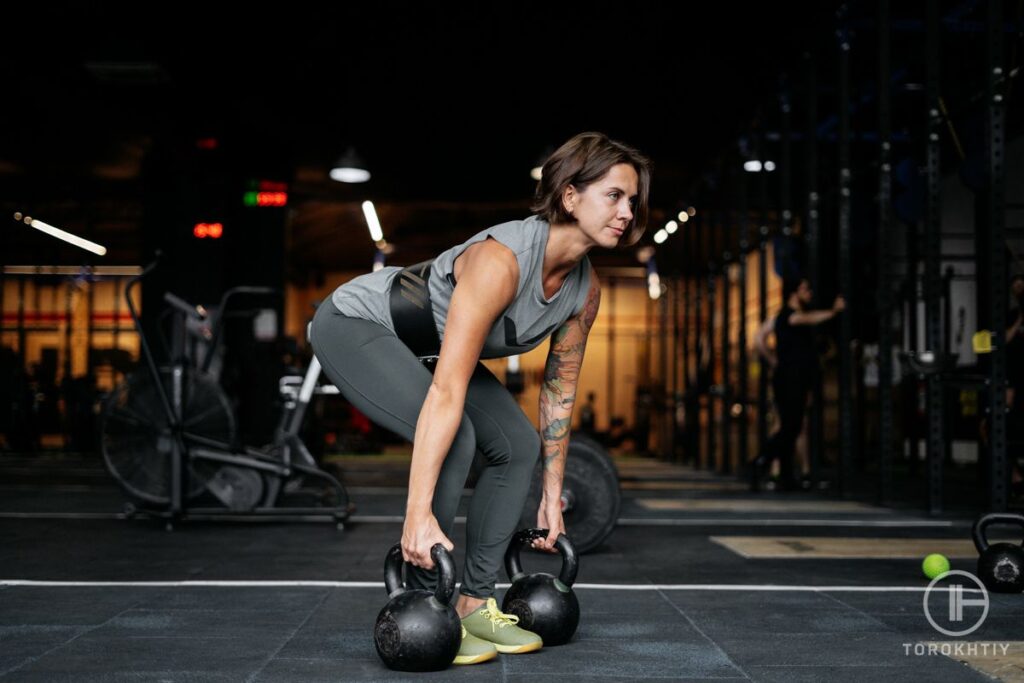
An important tip for beginners: Kettlebell swings are a momentum-driven exercise. It’s completely normal to start with a slower pace during the initial reps until your momentum naturally builds up, and you begin to experience the full dynamic power of the swing. Essentially, allow the laws of physics to guide you, just like you would on a swing at the playground. Trying to force the movement by adding excessive hip thrusts or using your hands to lift the weight not only diminishes the effectiveness of the exercise but also increases the risk of injury. Once you’ve gained momentum, at the top of the swing, your arms should be fully extended forward, and you should physically see the kettlebell. The weight should float in front of your face.
Muscle Engagement Throughout the Swing
Understanding when certain muscles should take effect is essential for properly performing any exercise. Here are the muscles kettlebell swings work out at each phase of the exercise and the rough order in which they activate:
| Kettlebell Swing Phase | Muscles Engaged |
|---|---|
| Starting position | Core, Quadriceps, Forearms |
| Hip Hinge | Hamstrings, Quadriceps, Glutes, Erector Spinae |
| Swing | Hamstrings, Quadriceps, Glutes, Forearms, Grip |
| Drive | Hamstrings, Quadriceps, Glutes, Forearms, Grip, Erector Spinae, Abdominals, Trapezius, Rhomboids |
| Float | Rotator Cuff, Trapezius, Rhomboids, Abdominals, Quadriceps |
| Descent | Rotator Cuff, Forearms, Grip, Abdominals, Erector Spinae, Quadriceps, Hamstrings, Glutes |
Kettlebell Swings Variations, And Muscles They Work
As with any exercise, one version is not the end-all, be-all, and people come up with different variations to expand their versatility. Fun fact: the original Kettlebell swing is sometimes referred to as the Russian Kettlebell swing, due to the origins of the exercise and the kettlebell itself. Here are some Kettlebell Swing variations to try:
Single-Arm Kettlebell Swing
Although the traditional Kettlebell swing is done using both hands, the single-handed variation is worth trying as well. The exercise motion remains the same, except you swing with one hand and use the other freely for balance. This variation is excellent for practicing unilateral balance and stability, as well as strengthening one arm, shoulder, and back portion at a time. Apart from being a fun switch-up from regular Kettlebell Swings, it’s great for physical therapy.
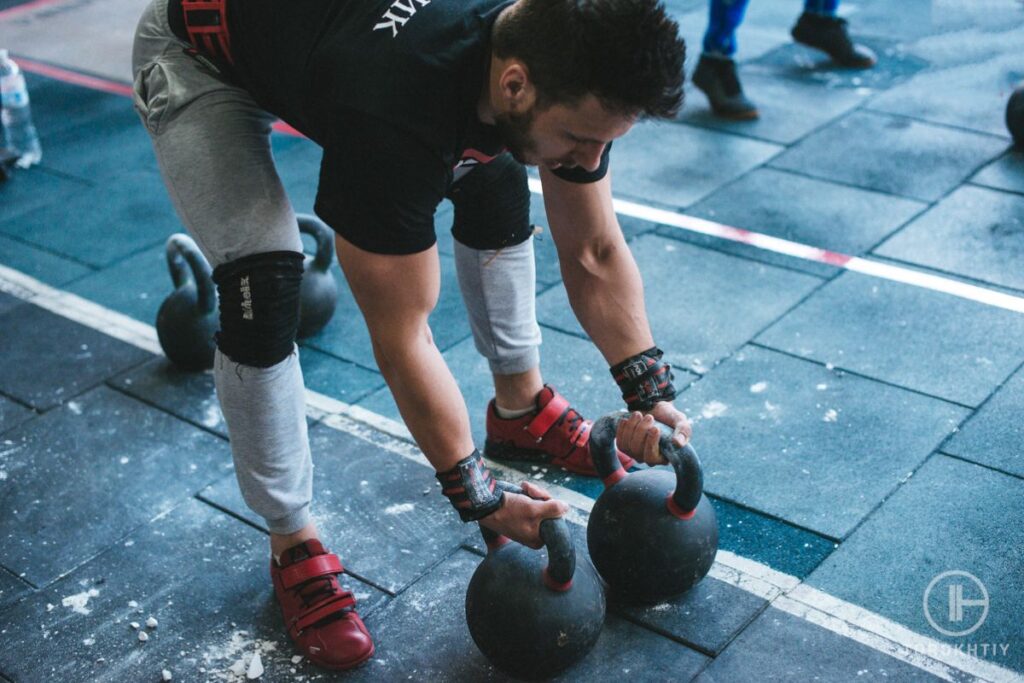
Alternating Kettlebell Swing
The Alternating Kettlebell Swing is essentially the same as the single-arm swing, except we want to switch (alternate) between hands mid-air. During the float phase, as the kettlebell reaches peak momentum, you’re going to let go of it with one hand and grip it with the other, and vice versa on every repetition. This variant is especially good for balance and coordination and engages the core (abdominals and obliques) to a greater extent.
Sumo Kettlebell Swing
The Sumo Kettlebell Swing variation closely resembles the traditional double-arm (Russian) Kettlebell Swing, with a distinctive difference in the initial posture. Instead of the regular stance, we adopt a Sumo stance, which involves positioning your feet much wider apart. To assume the Sumo stance, stand with your feet spread wider than shoulder-width and your toes angled outward up to 45 degrees. This modification enhances the activation of the glutes and core, providing added benefits, but it may be harder to perform depending on hip mobility.
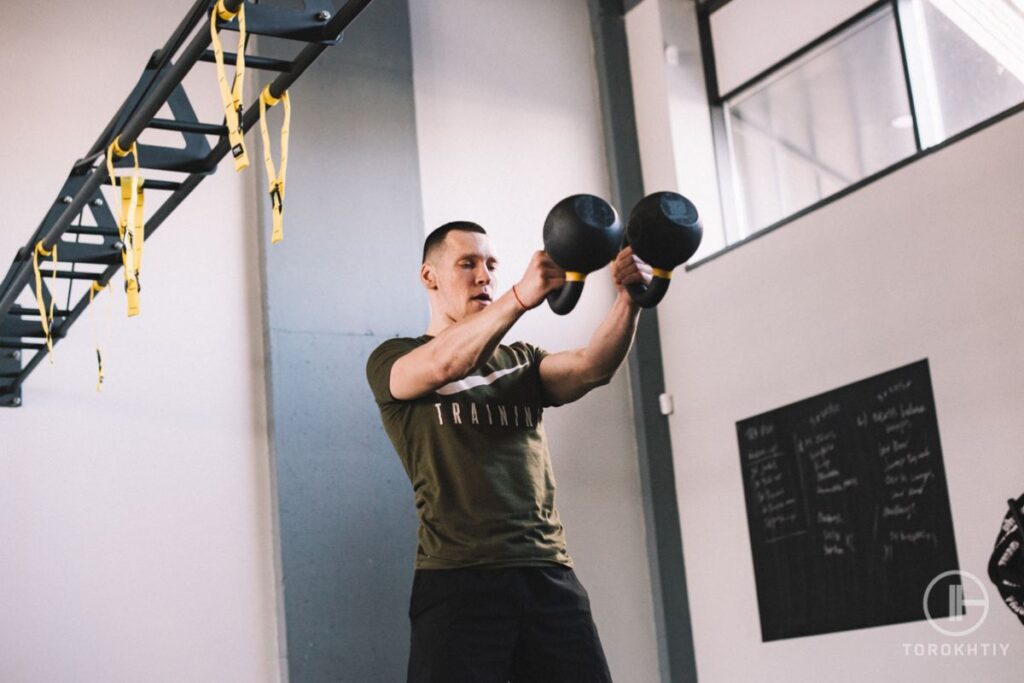
American Kettlebell Swing
As opposed to the traditional exercise, where the weight goes up to your face but not beyond it, the variation known as the American Kettlebell Swing ends with the kettlebell above your head. In this version, once the kettlebell is in the upward motion, you’re going to need to actively use your arms to lift the weight above your head. This exercise variation leads to greater activation of the upper body muscle groups, as well as the development of hand-to-eye coordination and overhead balance.
Incorporating Kettlebell Swings Into Your Workout Routine
Kettlebell Swings are versatile and can be used in many ways. With a slight change in weight increment, exercise speed, and repetitions, you can get different results. Here’s how you can incorporate them in various parts of your workout, depending on your fitness level and exercise goals.

Dynamic Warmup
Kettlebell swings can be a good addition to any dynamic/active warmup routine. The near full-body nature of the exercise and dynamic movement make it excellent for stimulating blood flow, getting your heart rate up, and promoting oxygen intake. When using Kettlebell Swings as part of your warmup routine, stick to low-weight increments and go for 2-3 sets of 20-30 reps at moderate speed.
Cardio Exercise
We’ve already talked about the effects of Kettlebell Swings on cardiovascular fitness. The next time you’re in line for some cardio exercise, but don’t feel like jumping on a treadmill or bike, consider Kettlebell Swings instead. You can also incorporate them into a dynamic cardio workout and split time with traditional cardio exercises. For effective cardio Kettlebell Swings, try a quick circuit workout. For example, 20-30 reps in 3-4 sets with a 30-60 second cooldown. Rest for two to three minutes and repeat for a total of 4-5 times.
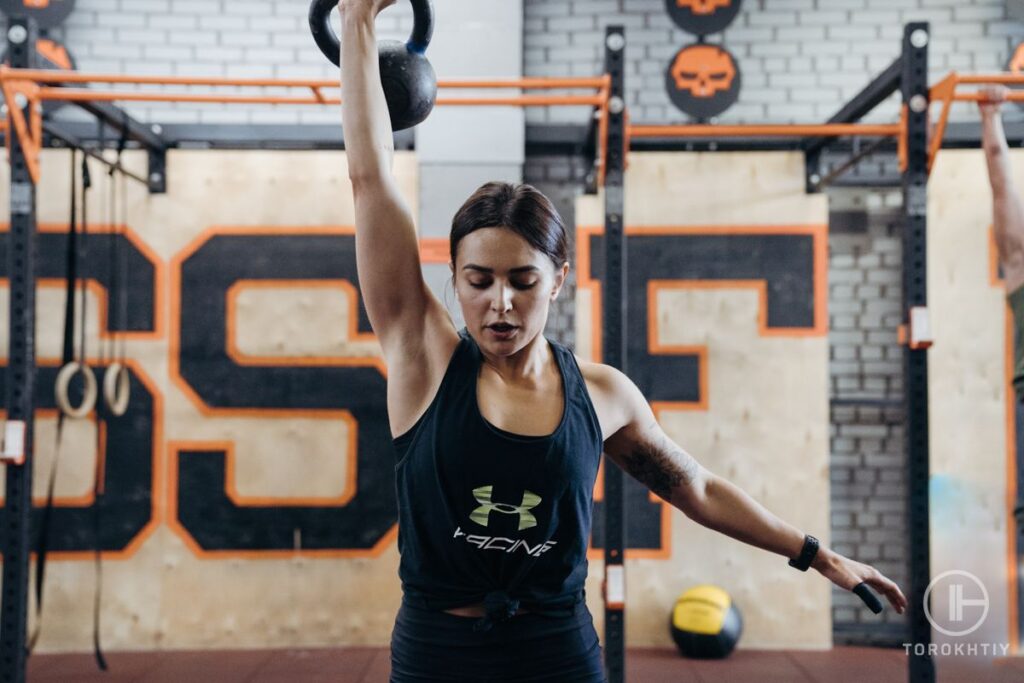
Back And/Or Core Exercise
Kettlebell swings slot excellently into any back or core day training regiment. For back days, they activate the posterior chain, strengthen the lower back, and add dynamic movement to shake up your body after tense resistance exercises. Otherwise, on core days, the exercise fits well as it requires core activation for stability and control, providing functional core strength (readiness, contraction speed) as opposed to just aesthetics like regular ab workouts. For an effective back or core Kettlebell Swing routine, stick to higher weight increments and low repetition. It’s simple and complex at the same time but remember that stimulating strength adaptations or/and hypertrophy requires specific volume (enough sets) and intensity – training close to failure.
Sports Prep
As a dynamic exercise, Kettlebell Swings can be used in functional fitness regiments, specifically for developing explosive power. A study comparing Kettlebell Swings to Jump Squats showed both exercises are effective at improving maximal and explosive strength. This proves Kettlebell Swings are highly beneficial for athletes who train in sports where explosive power and posterior strength play a crucial role, including basketball, football, MMA, etc. Professional or semi-professional athletes might find single-handed, alternating, and American-style kettlebell swings especially useful.
Cross-training
Athletes who prefer cross-training love exercises like Kettlebell Swings due to their all-encompassing nature. With just slight changes in speed and weight increments, as well as switching up exercise variations, Kettlebell swings can be incorporated into cross-training routines to work on cardiovascular health, posterior strength, balance & coordination, etc.
Kettlebells We Recommend
ROGUE KETTLEBELL – E COAT
- Weight range: 9-88 lbs.
- Increments: 9lb / 13lb / 18lb / 26lb / 35lb / 40lb / 44lb / 53lb / 62lb / 70lb / 80lb / 88lb
- Adjustable: No
- Handle diameter: 1.2″ (9lbs.-18lbs.), 1.4″ (26lbs.), 1.5” (35lbs.-88lbs.)
- Material: Cast Iron
- Coating: Black E-Coat, Semi-Gloss
- Color: Black
- Price per pound: ∼ $2.49
- Can be dropped? Yes
If you’re in the market for kettlebells, we highly recommend the Rogue E-COAT series. Manufactured in the U.S.A. by Cadillac Casting, Inc. using Ductile Cast Iron, these high-quality kettlebells will last forever. The premium black e-coat finish not only protects the metal against corrosion but also gives it a smooth, glossy finish using electrically applied paint that won’t chip away over time. The weight indicators are debossed into the metal, so they will not fade from use. Additionally, the markings are provided in both LB and KG, which is a thoughtful and user-friendly touch. These kettlebells are available in twelve sizes, ranging from 9 LB/4 KG to 88 LB/40 KG. There are also value sets available, which can make the purchase both easier and more affordable if you’re buying multiple kettlebells. Rogue is also proud to note that these kettlebells have been approved for use in the United States Army’s Combat Fitness Test, further attesting to their quality.
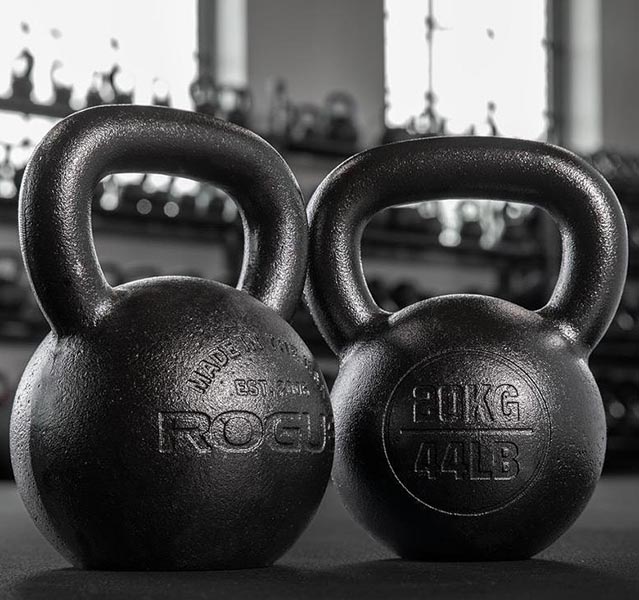
FAQ
Can You Build Muscle With Kettlebell Swings?
Kettlebell swings target muscles across the posterior chain and provides a full-body workout. You can expect to get a good dose of calorie burn and muscle activation from them, resulting in a leaner and toned body. However, you won’t notice the same major muscle growth (hypertrophy) from kettlebell swings as you would with traditional resistance training exercises.
What Are Kettlebell Swings Good For?
Kettlebell swings are good for many things. By targeting muscles in the posterior chain, they can lead to a stronger core, a more upright posture, and reduced lower back pain. As a dynamic movement, they help with improving strength, power output, your balance and coordination. They also carry cardiovascular benefits, including heart rate moderation, stamina increase, and calorie consumption.
What Happens If You Do 100 Kettlebell Swings A Day?
When you know the benefits of kettlebell swings, doing them every day may sound like a fun and easy challenge to set yourself. Depending on the weight you choose, you can expect to burn calories, tone your lower-body muscles, and increase your explosive power.
However, unless your body is conditioned for this type of movement, there’s a good chance you will be both mentally and physically fatigued if you attempt 100 swings per day if you don’t break them up into sets.
That said, kettlebell swings are a valuable tool for strength and conditioning programs, and coaches can recommend them to clients of all fitness levels, with 100 repetitions representing a nice milestone/achievement.
Conclusion
To recap: what muscles do kettlebell swings work? The main purpose of the exercise is to strengthen your posterior chain, which includes your glutes, hamstrings, calves, traps, rhomboids, and erector spinae. Apart from that, kettlebell swings target muscles in the core, arms, and shoulders. If you’re looking for good kettlebells to get, we highly suggest the Rogue E-Coat.
We’d love to hear from you as well. Do you use kettlebells as part of your workout routine? If so, have you tried Kettlebell Swing?
Let us know by leaving a comment and remember to follow us on social media, where we post lots of valuable fitness content.
Also read:
- Kettlebell Ab Workout
- Leg Workout With Kettlebell
- Beginner Kettlebell Workout
- Kettlebell Chest Workout
- Best Adjustable Kettlebells
- Best Resistance Bands for Building Muscle
- Benefits of Kettlebell Swings
References:
- “Gluteal Muscles”, physio-pedia.com https://www.physio-pedia.com/Gluteal_Muscles#:~:text=These%20muscles%20help%20stabilize%20the,internal%20rotation%20of%20the%20thigh. (accessed Sep. 19, 2023)
- “Hamstrings”. physio-pedia.com https://www.physio-pedia.com/Hamstrings#:~:text=knee%20slightly%20flexed-,Function%20of%20the%20hamstring%20muscle%20complex,the%20knee%20and%20hip%20joints. (accessed Sep. 19, 2023)
- “Trapezius”, physio-pedia.com https://www.physio-pedia.com/Trapezius (accessed Sep. 19, 2023)
- “Rhomboids”, physio-pedia.com https://www.physio-pedia.com/Rhomboids (accessed Sep. 19, 2023)
- “Abdominal Muscles”, physio-pedia.com https://www.physio-pedia.com/Abdominal_Muscles (accessed Sep. 19, 2023)
- “Rotator Cuff”, physio-pedia.com https://www.physio-pedia.com/Rotator_Cuff (accessed Sep. 19, 2023)
- “Effects of kettlebell mass on lower-body joint kinetics during a kettlebell swing exercise”, Levine NA, Hasan MB, Avalos MA, Lee S, Rigby BR, Kwon YH., Sports Biomechanics 2022 Oct;21(9):1032-1045. https://pubmed.ncbi.nlm.nih.gov/32131695/ (accessed Sep. 19, 2023)
- “Comparison of two-hand kettlebell exercise and graded treadmill walking: effectiveness as a stimulus for cardiorespiratory fitness”, Thomas JF, Larson KL, Hollander DB, Kraemer RR., The Journal of Strength & Conditioning Research 2014 Apr;28(4):998-1006. https://pubmed.ncbi.nlm.nih.gov/24345977/ (accessed Sep. 19, 2023)
- “Comparison of kettlebell swings and treadmill running at equivalent rating of perceived exertion values”, Hulsey CR, Soto DT, Koch AJ, Mayhew JL., The Journal of Strength & Conditioning Research, 2012 May;26(5):1203-7. https://pubmed.ncbi.nlm.nih.gov/22395274/ (accessed Sep. 19, 2023)
- “The Effects of Kettlebell Mass and Swing Cadence on Heart Rate, Blood Lactate, and Rating of Perceived Exertion during an Interval Training Protocol”, Corey Wesley, Derek Kivi, International Journal of Sports Science 2017, 7(3): 122-127 https://www.researchgate.net/profile/Derek-Kivi/publication/349773789_The_Effects_of_Kettlebell_Mass_and_Swing_Cadence_on_Heart_Rate_Blood_Lactate_and_Rating_of_Perceived_Exertion_during_an_Interval_Training_Protocol/links/60414779a6fdcc9c78122092/The-Effects-of-Kettlebell-Mass-and-Swing-Cadence-on-Heart-Rate-Blood-Lactate-and-Rating-of-Perceived-Exertion-during-an-Interval-Training-Protocol.pdf (accessed Sep. 19, 2023)
- “Kettlebell Swing Training Improves Maximal and Explosive Strength”, Lake, Jason P.; Lauder, Mike A., Journal of Strength and Conditioning Research 26(8):p 2228-2233, August 2012.https://journals.lww.com/nsca-jscr/fulltext/2012/08000/kettlebell_swing_training_improves_maximal_and.28.aspx (accessed Sep. 19, 2023)
Why Trust Us?
With over 20 years in Olympic Weightlifting, our team does its best to provide the audience with ultimate support and meet the needs and requirements of advanced athletes and professional lifters, as well as people who strive to open new opportunities and develop their physical capabilities with us.
By trusting the recommendations of our certified experts in coaching, nutrition, dietology, and sports training programming, as well as scientific consultants, and physiotherapists, we provide you with thorough, well-considered, and scientifically proven content. All the information given in the articles concerning workout programming, separate exercises, and athletic performance, in general, is based on verified data. We ensure that you can rely on our professionals’ pieces of advice and recommendations that can be treated as personalized ones which will benefit you and fully meet your needs.
The product testing process is described in more detail here
Author: Ihor Shymechko
Pro Olympic Weightlifter, Coach
Best Results: Snatch – 208 kg,
C&J – 240 kg
Ihor has been a professional weightlifter since 1996, boasting over two decades of competition experience. His notable achievements include clinching the European Championship in 2009 and securing a silver medal in the 105kg division at the Senior World Championships in 2011. Ihor represented his country in the 2008, 2012, and 2016 Summer Olympics. After retiring from competitive weightlifting, he transitioned to coaching, leveraging his vast experience to guide athletes who now compete on both national and international stages.

